Physical Address
304 North Cardinal St.
Dorchester Center, MA 02124
The coronary circulation is composed of several types of blood vessels, each with different structure and function, including the superficial conductive arteries, prearterioles, arterioles (resistance vessels), capillaries, and veins.
The major determinants of coronary blood flow are extravascular compression, metabolic regulation, pressure-flow autoregulation, and the autonomic nervous system.
In the left coronary circulation, extravascular compressive forces during systole (due to high developed left ventricular [LV] intracavitary pressure) result in coronary blood flow occurring predominantly during diastole. In contrast, right ventricular (RV) perfusion is relatively constant throughout the cardiac cycle because RV systolic pressure is lower than aortic pressure.
Oxygen extraction by the LV is nearly maximal under baseline conditions. As a result, increases in myocardial oxygen consumption are critically dependent on proportional increases in coronary blood flow mediated by locally produced vasodilating factors (metabolic regulation).
Metabolic regulation is a feed-forward mechanism based on the action of carbon dioxide and oxygen-derived free radicals produced by cardiac myocytes and involves endothelium-derived nitric oxide (NO) and adenosine triphosphate-sensitive potassium (K ATP ) channels in vascular smooth muscle.
Coronary flow reserve (the ratio of maximum to resting coronary blood flow) is substantial in the normal LV and RV (approximately 500% to 600%), but it may be reduced by epicardial coronary stenosis, ventricular hypertrophy, hemodilution, hypoxemia, hypercapnia, or microvascular dysfunction. Coronary flow reserve is exhausted when stenosis severity reaches approximately 90%.
A reduction in coronary vasodilator reserve can compromise effective metabolic regulation and contribute to the development of myocardial ischemia or infarction.
In the presence of an epicardial coronary stenosis (blood flow restriction), myocardial ischemia can be inhibited by interventions that reduce myocardial oxygen demand, such as those that decrease heart rate and myocardial contractility. This principle forms the basis for the use of β-blockers in patients with coronary artery disease. Analogously, an intentional increase in myocardial oxygen demand provoked with a positive inotropic medication reproducibly causes regional wall motion abnormalities indicative of ischemia when flow-limiting coronary stenoses are present and is the basis of dobutamine stress echocardiography.
Autoregulation in response to decreased perfusion pressure in a left coronary artery fails first in the LV subendocardium, rendering this region most susceptible to ischemia, contractile dysfunction, and infarction.
The RV is less susceptible than the LV to myocardial ischemia and infarction because of its more favorable hemodynamic characteristics.
The coronary arterioles (resistance vessels) are richly endowed with adrenergic and muscarinic receptors and are supplied by the sympathetic and parasympathetic nervous systems. The influence of these autonomic pathways is normally overridden by locally produced metabolic factors in the LV.
The right coronary circulation is more sensitive to the influence of sympathetic vasoconstriction than is the left coronary circulation.
Collateral vessels between coronary arterial branches may develop gradually over time in response to ischemia and can provide protection against infarction when coronary artery occlusion occurs.
Coronary steal refers to the ability of a vasodilator to cause a redistribution of coronary blood flow away from a collateral-dependent region with marginal perfusion to an area with adequate perfusion.
Alterations in arterial blood gas composition can have profound effects on coronary blood flow and myocardial oxygen supply/demand balance. Hyperoxia and hypocapnia are coronary vasoconstrictors that have the potential to limit coronary blood flow and cause myocardial ischemia.
Hypoxia is a coronary vasodilator that increases blood flow in proportion to the decrease in arterial oxygen content (if coronary reserve is sufficient), thus maintaining myocardial oxygen supply and oxygen consumption.
Hypercapnia is a coronary vasodilator that has the potential to cause coronary steal in the obstructed coronary circulation.
Metabolic vasodilation is the principal mechanism by which myocardial oxygen delivery is maintained during hemodilution. A diminished coronary flow reserve, such as occurs with a large vessel coronary stenosis, impairs the efficacy of this compensatory response.
The contractile function of the thin-walled RV is exquisitely sensitive to afterload. Acute increases in pulmonary arterial pressure reduce RV stroke volume, and if sufficiently large and prolonged, result in RV failure. Right ventricular ischemia plays a prominent role in these effects.
Despite the impediment to coronary blood flow imposed by increased extravascular compressive forces, metabolic mechanisms are effective in maintaining myocardial oxygen supply (blood flow) commensurate with the diminished oxygen demand during moderate cardiac tamponade. Myocardial ischemia does not substantially contribute to impaired cardiac function under this condition.
In 1628 British physician William Harvey (1578–1657) made the revolutionary discovery of a blood circulation consisting of a pump and a system of distributing vessels. Although the ancient Greek physician Galen was first credited with introducing the term “coronary arteries” (the crowning arteries) for the blood supply to the heart, it was Harvey who first proposed that these vessels supplied “nutrition” to the heart muscle (oxygen had yet to be discovered). He wrote “besides, if the blood could permeate the substance of the septum, or could be imbibed from the ventricles, what use were there for the coronary artery and vein, branches of which proceed to the septum itself, to supply it with nourishments.” Subsequent anatomical studies conducted in the late 1600s and early 1700s provided additional details about the heart’s blood supply, and by the turn of the 18th century, the anatomical framework of the coronary circulation had been clarified. However, two centuries would elapse before comprehensive studies of coronary physiology would be undertaken. Seminal experiments in the late 18th and early 19th centuries identified the physical determinants of blood flow (Poiseuille’s law) and led to the discovery of hemoglobin and its ability to bind oxygen. These discoveries provided a foundation for the study of coronary physiology by defining the basic principles governing tissue blood flow and oxygen transport. A coherent, detailed picture of the vascular control mechanisms governing coronary blood flow and myocardial oxygen supply subsequently emerged from physiological studies in animal models.
This chapter will describe the major determinants of coronary blood flow, including extravascular compression, metabolic regulation, the vascular endothelium, pressure-flow autoregulation, and neural modulation of the coronary circulation ( Box 6.1 ). Because of its essential role in maintaining coronary blood flow (myocardial oxygen supply) commensurate with cardiac work (oxygen demand), metabolic regulation will receive particular emphasis. The critical importance of sufficient vasodilator reserve for effective flow-metabolism coupling will also be emphasized, as will the ability of an epicardial coronary artery stenosis or microvascular dysfunction to compromise the metabolic control mechanism, thus rendering the myocardium at risk of demand-induced ischemia. The left and right ventricles (LV and RV, respectively) have important structural and functional differences that are the basis for differences in their perfusion characteristics, including the phasic pattern of blood flow and the relative effectiveness of pressure-flow autoregulation. These topics will also be addressed here. Finally, flow-related phenomena including coronary artery spasm and coronary steal, and the mechanistic basis for the coronary blood flow responses during arterial blood gas derangements, hemodilution, RV adaptation to acutely elevated load, and cardiac tamponade will also be discussed. A thorough understanding of coronary physiology is essential when caring for patients with many forms of acquired heart disease undergoing cardiac and noncardiac surgery.
Extravascular compressive forces during systole
Metabolic regulation
Endothelial function
Pressure-flow autoregulation
Autonomic nervous control
An understanding of the physical determinants of tissue blood flow provides a basis for a discussion of its control in the heart. In 1842, Jean Leonard Marie Poiseuille (1797–1869), a French physicist and physiologist, applied hydraulic principles to first describe the determinants of blood flow. , Poiseuille’s experiments established two major principles: (1) flow is equal to the pressure difference across a tube divided by its resistance and (2) resistance varies directly with the fluid’s viscosity and the length of the tube, and inversely with the fourth power of its radius. Poiseuille’s work was revolutionary, as blood flow dynamics and the forces governing it were not well understood at the time. In particular, Poiseuille’s demonstration that small changes in vessel radius had a profound impact on blood flow stimulated intense research to characterize the regulation of vasomotor tone, which eventually led to studies of the coronary circulation. The physiological relevance of Poiseuille’s law has been criticized because it strictly applies only to continuous (nonpulsatile) laminar flow in a rigid tube with a Newtonian fluid (one in which viscosity remains constant and does not vary with the shear rate), conditions that are not met in intact blood vessels. Nevertheless, Poiseuille’s law provides a useful model of blood flow dynamics in vivo and continues to serve as a foundational principle for understanding the circulation in which blood flow (F) is a function of the arterial-venous pressure gradient (P a -P v ) and local vascular resistance (R) such that F = (P a -P v )/R. Since arterial and venous pressures are normally well maintained within narrow limits by homeostatic mechanisms, it is clear that blood flow varies inversely as a function of vascular resistance, which results from contraction or relaxation of vascular smooth muscle that invests the arterioles (the principal site of vascular resistance). Changes in blood viscosity (largely determined by hematocrit) also play a relatively minor role in determining blood flow except when severe polycythemia or profound hemodilution is present.
The coronary arterial circulation has three functionally distinct compartments containing the large arteries (proximal), prearterioles (intermediate), and arterioles (distal) ( Box 6.2 ). , The proximal compartment is composed of the large epicardial coronary arteries (0.5 to 5 mm in diameter), which have capacitance and conductive functions and normally offer negligible resistance to blood flow. The large coronary arteries are responsive to flow-mediated vasodilation. These superficial coronary arteries give rise to narrower arterial vessels that penetrate into the ventricular walls. The intermediate compartment is composed of the prearterioles (100 to 500 μm in diameter), which exhibit a moderate drop in pressure along their length and make a small contribution to overall coronary vascular resistance. The prearterioles are not under the influence of vasoactive metabolites because of their extramyocardial location. Their principal function is to maintain pressure at the origin of the arterioles within a narrow range during changes in coronary perfusion pressure and blood flow. This adjustment is accomplished by alterations in vascular caliber through a myogenic mechanism, that is, the intrinsic tendency of vascular smooth muscle to contract or relax in response to increased or decreased tension, respectively. The distal compartment is composed of the intramural arterioles (<100 μm in diameter), which are the site of the most significant drop in pressure and are the primary determinant of coronary vascular resistance. The arterioles normally have a high resting tone and a substantial vasodilator reserve. These vessels are highly responsive to the vasoactive metabolites produced by the myocardium (local metabolic regulation). The terminal arterioles supply the thin-walled capillaries, which are the site of exchange of oxygen between the blood and the cardiac myocyte. Myocardium is characterized by a high density of capillaries, as the ratio of capillaries to muscle fibers is nearly 1:1. The capillaries are not all open under basal conditions, but their recruitment plays a critical adaptive role in maintaining myocardial oxygen tension when demand is increased ( Fig. 6.2 ). , The coronary venous system collects the deoxygenated blood and returns it to the right side of the circulation for reoxygenation, primarily through the coronary sinus.
Large conducting epicardial coronary arteries (>500 μm)
Supply oxygenated blood to distal coronary vasculature
Prearterioles (100–500 μm)
Minor contributor to vascular resistance
Maintain pressure at origin of arterioles
Arterioles (<100 μm)
Primary site of vascular resistance
Highly responsive to vasoactive metabolites
Capillaries
High density
Site of oxygen delivery to myocardium
Under baseline conditions, only a portion of total perfused
Recruited when myocardial oxygen demand increased
Venules, Veins, and Coronary Sinus
Collect deoxygenated blood for return to the right heart
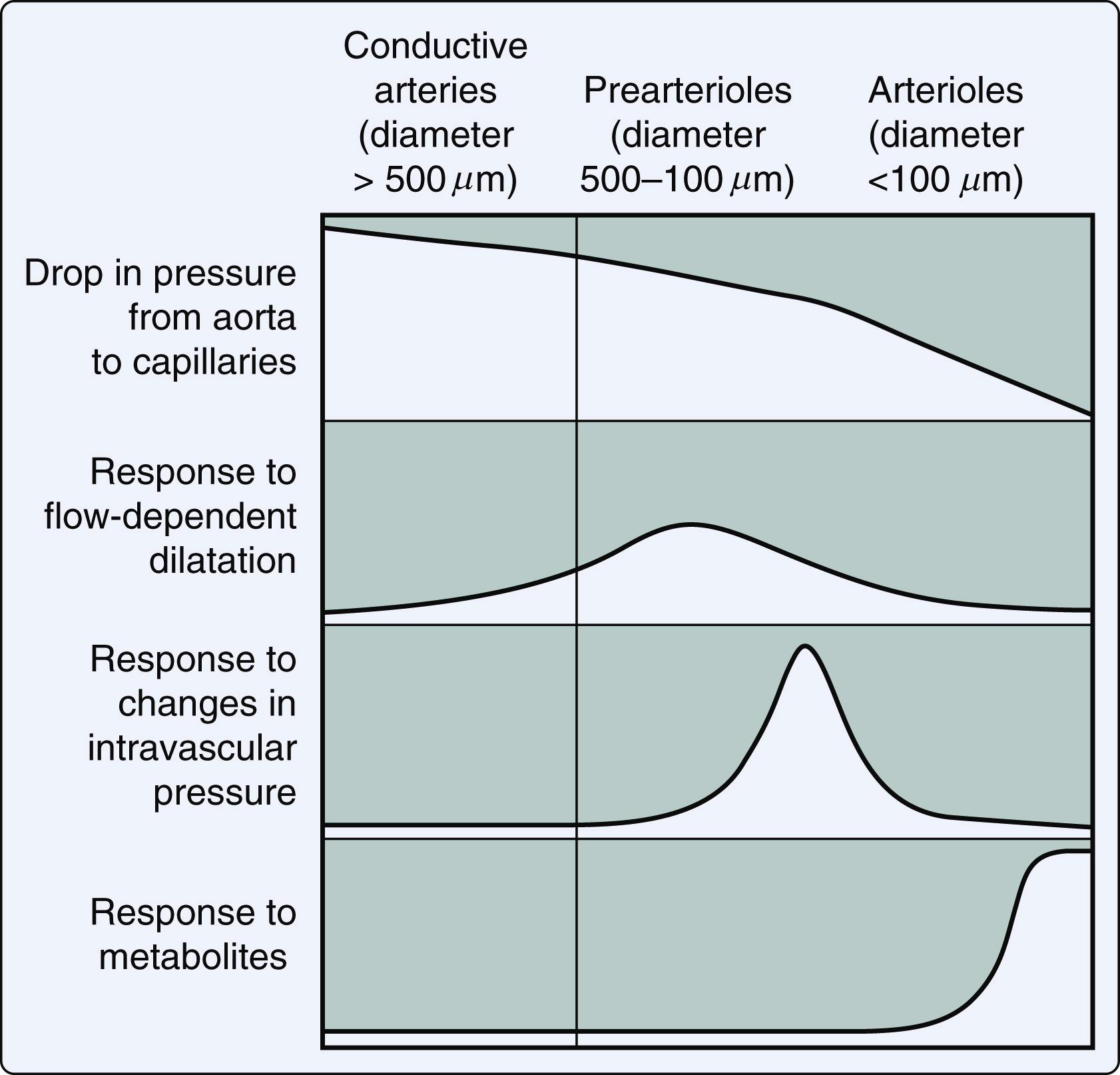
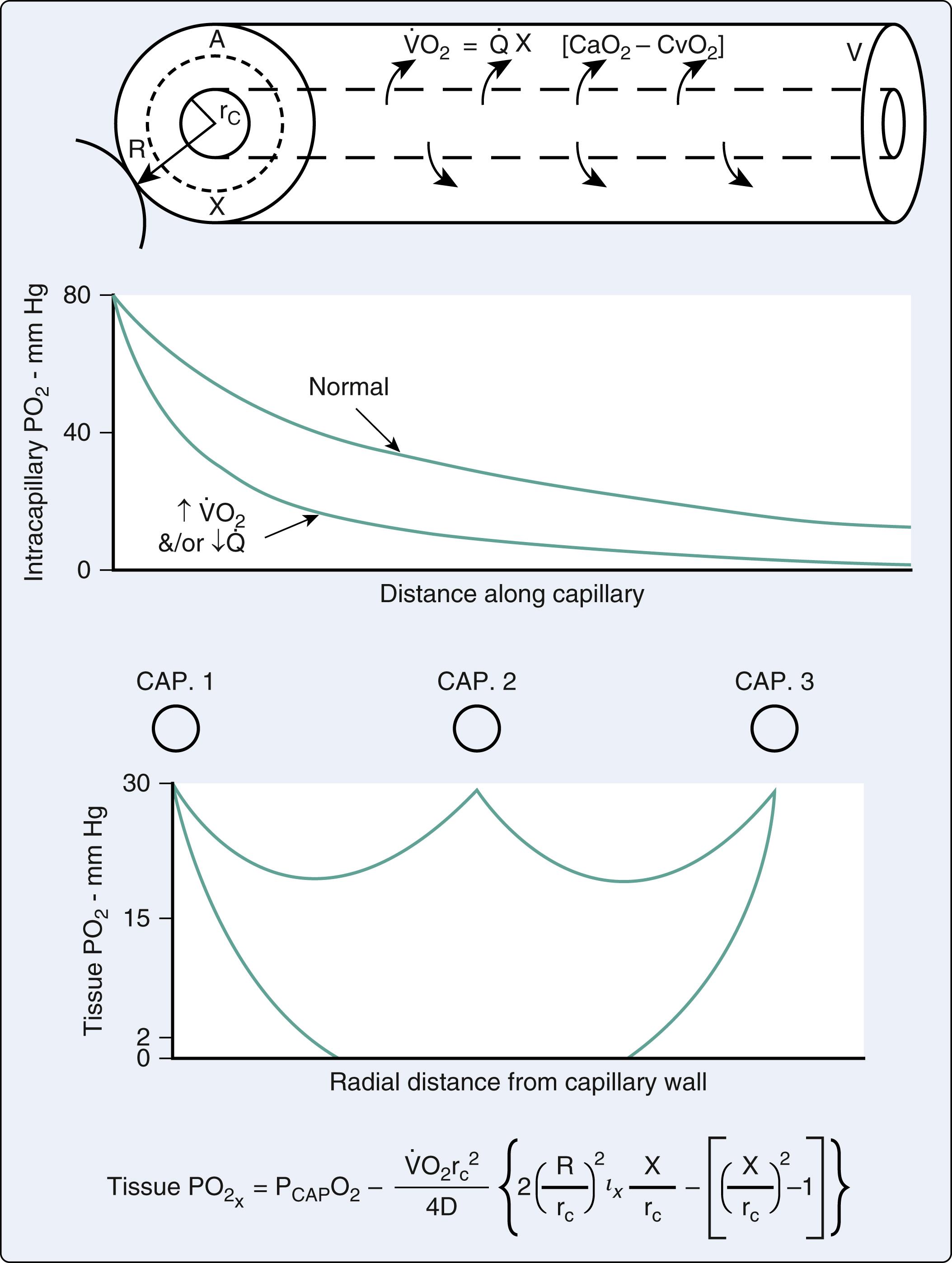
Phasic measurements of coronary blood flow indicate that flow to the LV occurs predominately during diastole ( Box 6.3 ) ( Fig. 6.3 ). The inhibition to LV blood flow during systole results from extravascular compressive forces exerted on intramural vessels located predominantly in the subendocardium. Preferential subendocardial flow occurs in the LV during diastole, compensating for its inhibition during systole, and preserving uniform transmural LV perfusion. The primary mechanism for this response is a metabolically mediated reduction in coronary vasomotor tone. Interestingly, uniform perfusion across the LV wall was also observed after coronary vasomotor tone was intentionally abolished using an intracoronary infusion of the vasodilator papaverine. This finding is consistent with a transmural gradient of vascularity that favors the subendocardium and provides a second compensatory mechanism to counteract the systolic flow limitation in that region of the LV wall. Tachycardia shortens diastole but subendocardial blood flow normally remains adequate because of recruitment of the coronary flow reserve. However, when this reserve is compromised (e.g., by a large vessel coronary stenosis or LV hypertrophy ), tachycardia may precipitate or exacerbate subendocardial ischemia. In contrast to the LV, RV systolic intramyocardial pressure is low and does not produce compressive forces that impede blood flow. Indeed, RV blood flow is appreciable throughout the entire cardiac cycle, essentially following the contour of the aortic pressure curve ( Box 6.3 , Box 6.4 ) , Measurements of phasic flow velocity obtained in patients using a Doppler flow probe demonstrated that the ratio of systolic to diastolic blood flow velocity in the RV branches of the right coronary artery (RCA) was threefold greater than in the left anterior descending coronary artery (LAD). RV pressure overload or compensatory hypertrophy associated with acute or chronic pulmonary artery hypertension, respectively, are accompanied by increases in RV intramyocardial pressure such that RV perfusion becomes more diastole-dominant and resembles the flow pattern observed in the LV (see the following section).
High systolic pressure limits appreciable flow to diastole
Flow low relative to oxygen consumption resulting in high oxygen extraction, low coronary venous PO 2 , and minimal oxygen extraction reserve
Flow tightly coupled to the oxygen demand by metabolic mechanism
Autoregulatory mechanism maintains flow nearly constant over wide range of perfusion pressures
Flow normally uniform across LV wall, but becomes maldistributed (subendocardium < subepicardium) in presence of an epicardial coronary stenosis
Influence of autonomic nervous system subordinate to metabolic regulation
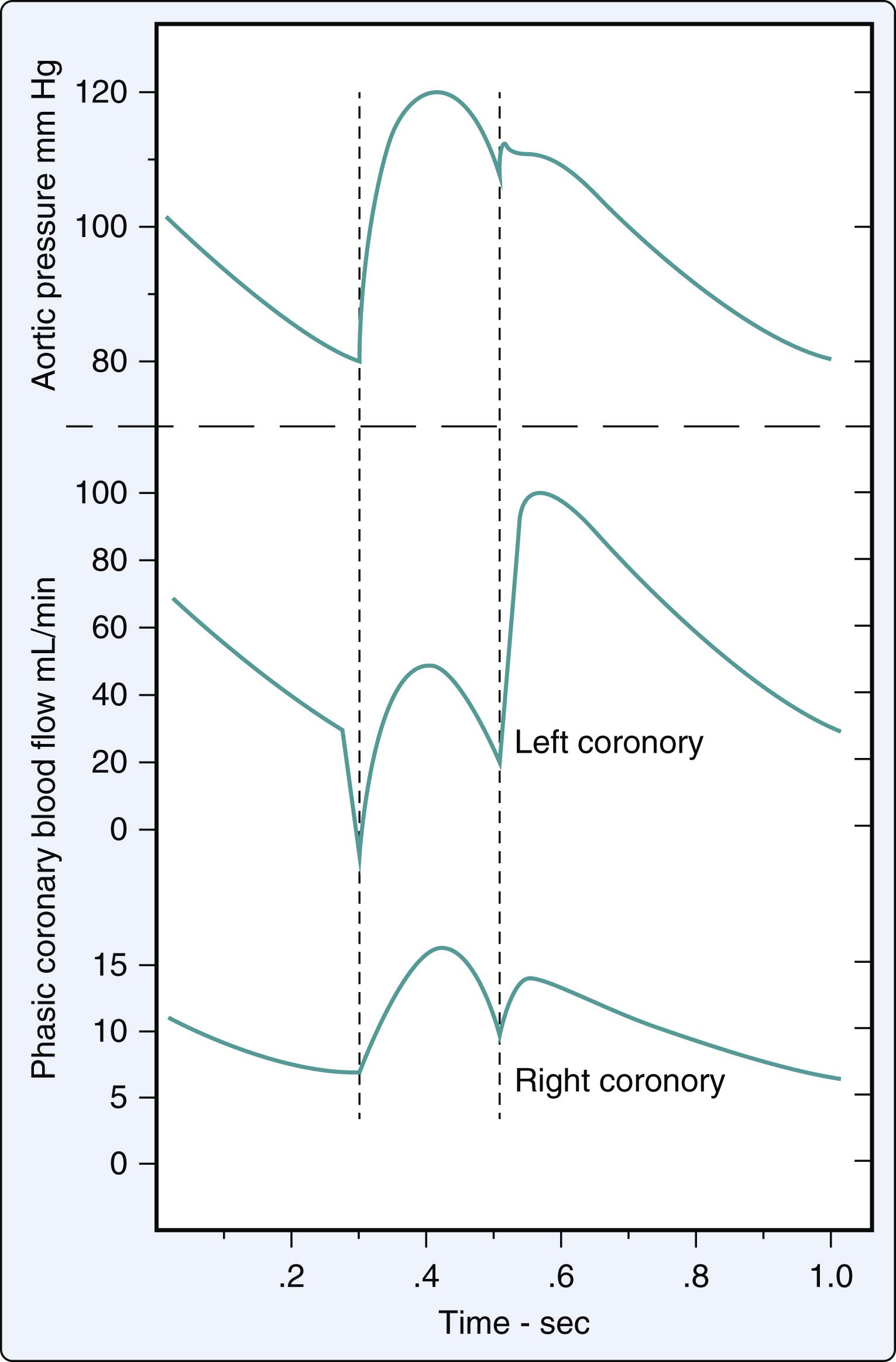
Lower systolic pressure results in appreciable blood flow throughout the entire cardiac cycle
Smaller baseline myocardial oxygen uptake, blood flow, and oxygen extraction
Significant oxygen extraction reserve
Less effective pressure-flow autoregulation
Ability to downregulate metabolic demand during hypoperfusion (i.e., hibernation) and maintain contractile function and energy stores
Transmurally-uniform reduction in myocardial perfusion in presence of epicardial coronary stenosis
Enhanced vasoconstrictor response to sympathetic nerve stimulation
The heart depends almost exclusively on aerobic metabolism to meet its energy demands. More than 95% of adenosine triphosphate (ATP) generated by the cardiac myocyte is derived from oxidative phosphorylation within the mitochondria. Free fatty acids, glucose, and lactate are the principal substrates for ATP production. The high-energy expenditure of the heart is underscored by the observation that it accounts for approximately 7% of the body’s basal oxygen use despite comprising less than 0.5% of total body weight. When oxygen availability is limited, the cardiac myocyte uses an anaerobic glycolytic pathway in the cytoplasm to convert glucose to lactate for energy production. Indeed, an elevated lactate concentration in the coronary venous effluent is an indicator of myocardial ischemia. Anaerobic glycolysis has a very limited ability to fulfill the energy requirements of the myocardium, as contraction ceases within 10 to 15 seconds after coronary blood flow is interrupted. Effective matching of coronary blood flow (oxygen supply) to myocardial oxygen demand is essential for optimal cardiac performance. This is accomplished by an intrinsic regulatory mechanism, termed “metabolic regulation,” in which the cardiac myocytes release vasodilating substances that directly modulate coronary arteriolar tone, and thereby coronary blood flow, according to their current oxygen demand.
Metabolic regulation of coronary blood flow was first postulated by Barcroft and Dixon in 1907, but it was not until 1947 that Eckenhoff et al. provided compelling evidence for its existence in a canine model. In these experiments, stroke work and oxygen demand were varied by increasing LV afterload (acute aortic occlusion), preload (volume loading), or myocardial contractility (intravenous administration of epinephrine) ( Box 6.5 ). Eckenhoff’s data demonstrated a strong parallel relationship between left coronary blood flow and myocardial oxygen consumption (calculated using the Fick equation; Fig. 6.4 ), indicating a tight coupling between these parameters. Furthermore, the findings showed that myocardial oxygen extraction is nearly maximum under baseline conditions: 75% of oxygen was extracted from the blood as it passed from the arterial to venous side of the capillary network (corresponding to a coronary sinus oxygen tension of approximately 20 mm Hg). As a result, the LV has a very limited oxygen extraction reserve, and is essentially dependent on increases in blood flow to satisfy increases in oxygen demand. Such compensatory increases in flow occur through recruitment of arteriolar vasodilator reserve by metabolites produced in the myocardium. A constant value for coronary sinus oxygen tension is a hallmark of effective metabolic control of coronary blood flow. This mechanism has been observed in all mammalian species studied, including humans. , ,
Wall tension
Systolic ventricular pressure
Ventricular volume
contractility
Heart rate
Afterload (systolic wall stress)
Preload (diastolic wall stress)
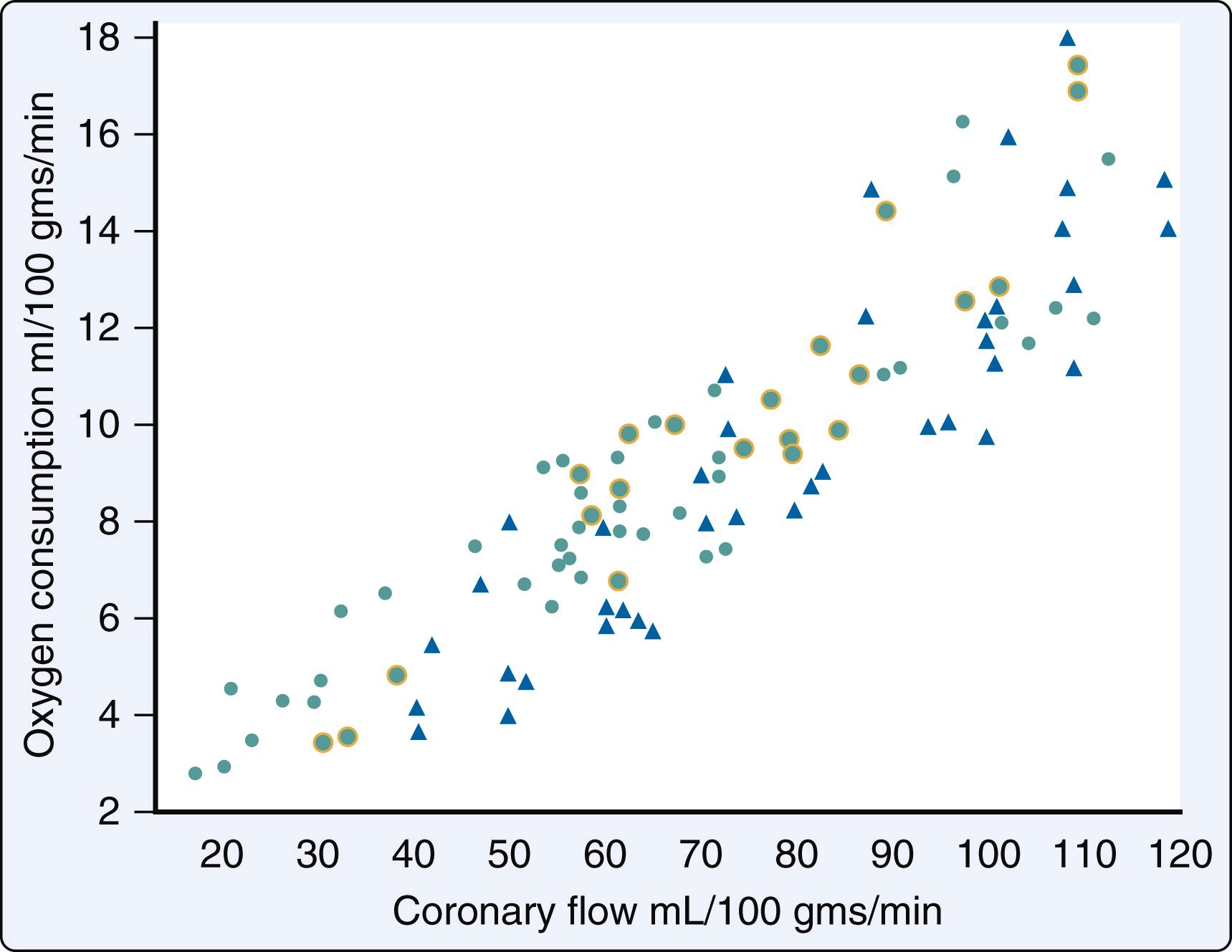
The earliest measurements of myocardial oxygen consumption were performed in the LV because its venous drainage into the coronary sinus is readily accessible. Several laboratories also mastered the technique required to obtain venous effluent from the small, delicate superficial veins draining the RV, which enabled measurements of myocardial oxygen consumption in both chambers simultaneously. These studies demonstrated that baseline values for myocardial oxygen consumption are much smaller in the RV compared with the LV ( Table 6.1 ), , which is consistent with the disparity in pressure-volume work between the chambers. The reduced oxygen consumption of the RV is the result of lower values for both blood flow and oxygen extraction. RV blood flow (per 100 g tissue) is approximately two-thirds that of the LV. Thus baseline coronary vascular resistance (the ratio of perfusion pressure to blood flow) is substantially greater in the RV compared with the LV. The RV’s smaller myocardial oxygen extraction indicates that blood flow is high relative to oxygen consumption. This relative “overperfusion” of the RV has been attributed to a blunting of right coronary vasoconstriction by NO (a coronary vasodilator) that is released tonically from the vascular endothelium. Indeed, antagonism of NO synthesis caused a reduction in resting right coronary blood flow. However, this intervention had no effect on resting blood flow in the left coronary circulation. The sustained basal release of NO in the right coronary circulation may be related to a greater vascular resistance, blood flow velocity, and shear stress. The RV’s lower oxygen extraction provides it with an oxygen extraction reserve that can be exploited, along with increases in blood flow, to meet an increased oxygen demand ( Table 6.1 ). , The relative importance of oxygen extraction in the RV versus LV is consistent with their respective capillary reserves, as measured using stop-motion microcinematography in rat hearts. These experiments demonstrated that the capillary reserve of the RV was approximately twice that of the LV, and was the result of a smaller number of open capillaries at baseline and a greater total capillary density.
| Right Ventricle | Left Ventricle | ||||
|---|---|---|---|---|---|
| Baseline b | Isoproterenol b | Baseline b | Isoproterenol b | ||
| MVO 2 | 4.8 ± 1.3 | 8.2 ± 1.6 c | 10.6 ± 0.9 | 14.2 ± 1.8 c | |
| (mL/min/100g) | |||||
| MBF | 59 ± 12 | 73 ± 12 c | 84 ± 16 | 104 ± 14 c | |
| (mL/min/100g) | |||||
| A-VO 2 diff. | 9.1 ± 1.1 | 11.4 ± 1.0 c | 13.5 ± 0.8 | 14.3 ± 0.8 | |
| (mL O 2 /100 mL blood) | |||||
| O 2 extraction | 42 ± 5 | 51 ± 3 c | 63 ± 4 | 64 ± 3 | |
| (%) | |||||
| Lactate Ext | 56 ± 11 | 50 ± 11 | 60 ± 8 | 51 ± 10 | |
| (%) | |||||
| Systemic Variables | |||||
| CI | 65 ± 6 | 89 ± 9 c | |||
| (mL/min/kg) | |||||
| MAP | 111 ± 99 | 99 ± 5 c | |||
| (mm Hg) | |||||
| RVSP | 27 ± 1 | 29 ± 1 | |||
| (mm Hg) | |||||
| PCWP | 5.0 ± 1.0 | 3.7 ± 1.5 c | |||
| (mm Hg) | |||||
| HR | 63 ± 4 | 64 ± 3 | |||
| (beats/min) | |||||
a Isoproterenol, 0.1 μg/kg/min iv, in anesthetized, open-chest dogs caused increases in oxygen consumption in both ventricles but only the right ventricle satisfied this, in part, by recruitment of an oxygen extraction reserve.
Studies in chronically instrumented dogs shed light on the interplay between increases in RV coronary blood flow and oxygen extraction during graded treadmill exercise. These studies demonstrated that the RV relies preferentially on increases in oxygen extraction at low levels of exercise, whereas the contribution of blood flow becomes prominent during more intense exercise when the coronary venous oxygen tension falls to approximately 20 mm Hg. These observations in the RV, and those described previously for the LV, support the contention that a coronary venous oxygen tension of 20 mm Hg is the critical value for activation of a metabolically linked coronary vasodilator response.
Current concepts of metabolic regulation implicate a “feed-forward” mechanism in which vasodilating metabolites are produced by the myocardium in proportion to the level of cardiac work ( Fig. 6.5 ). The primary metabolites proposed to mediate this process are carbon dioxide (generated in citric acid cycle decarboxylation reactions) and reactive oxygen species (formed in the mitochondrial respiratory chain). NO and adenosine triphosphate-sensitive potassium (K ATP ) channels are likely downstream mediators of this flow response. Adenosine, a breakdown product of ATP, is a potent endogenous vasodilator that was once thought to play a central role in metabolic regulation of coronary blood flow, but it is now presumed that adenosine is involved only in the presence of tissue hypoxia, which is the main stimulus for its production. Whether vasodilation occurs in response to an endogenous local metabolite or to an exogenously administered drug, it requires relaxation of vascular smooth muscle due to a decrease in intracellular Ca 2+ concentration and an increase in myosin light chain phosphatase activity.
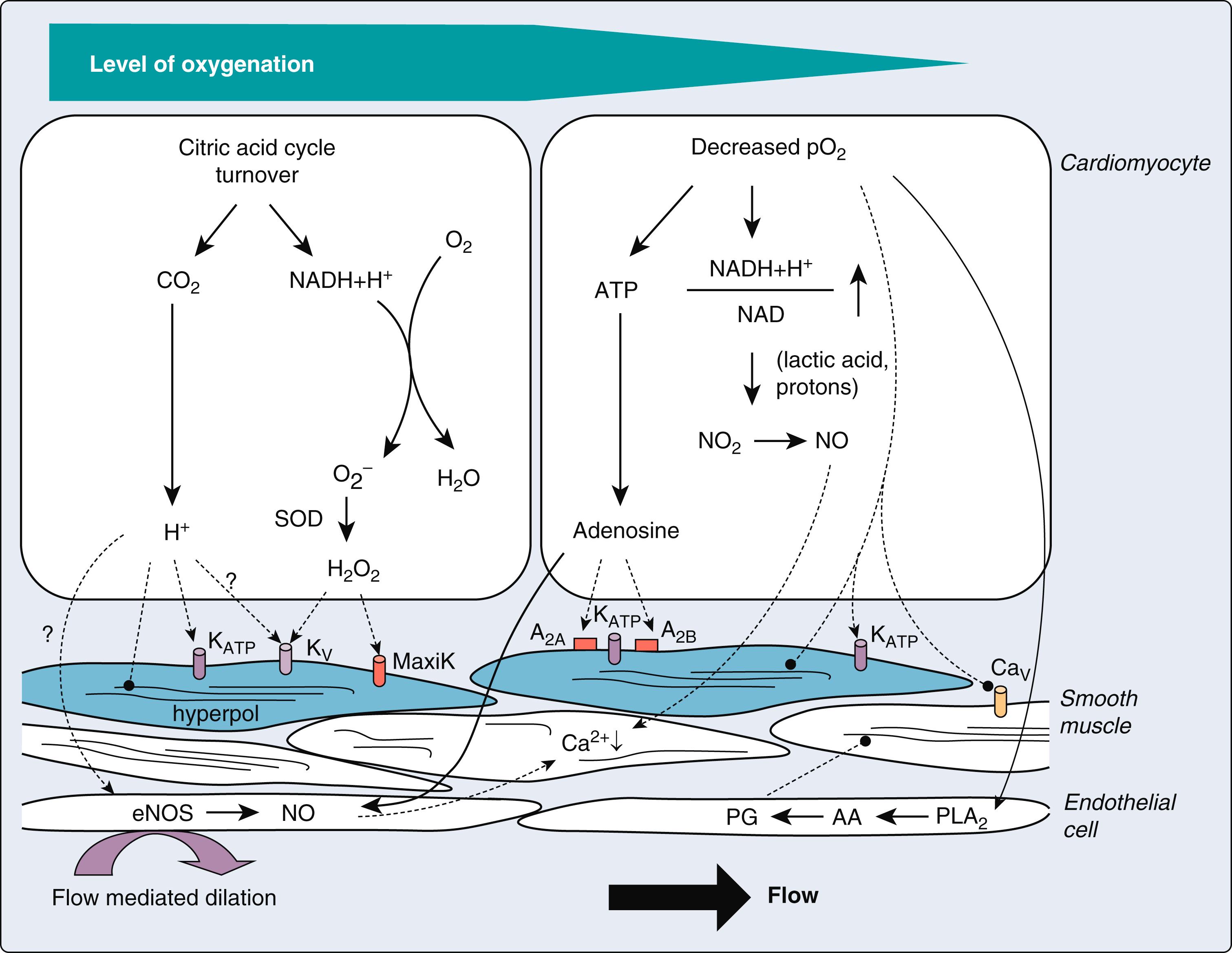
As recently as the early 1970s, the endothelial lining of blood vessels was viewed as a “sheet of nucleated but inert cellophane.” However, it became apparent, based on new in vitro research techniques developed in that era, that the endothelium is a profoundly dynamic “biochemical machine” serving many diverse physiological roles. Most relevant to this chapter is that the vascular endothelium was demonstrated to produce a number of molecules, the most prominent of which is NO, that are integral to the regulation of coronary vasomotor tone. The discovery of NO as an endogenous mediator of vasodilation was based on the observation by Furchgott and Zawadzki in 1980 that acetylcholine-induced relaxation of isolated segments of rabbit aorta required an intact endothelium. This finding led to the conclusion that acetylcholine acted on muscarinic receptors located on the endothelial membrane to cause release of a vasodilating substance, which they termed “endothelium-derived relaxing factor.” Seven years later, this factor was definitively identified as NO. It is now recognized that NO is a ubiquitous molecule that plays many essential roles not only in the circulatory system, but also in immunological responses and as a central nervous system neurotransmitter. NO is a free radical synthesized from L-arginine in a reaction requiring the constitutive enzyme NO synthase (NOS) ( Fig. 6.6 ). An increase in intracellular Ca 2+ concentration, which occurs in response to activation of specific membrane receptors (eg, bradykinin, acetylcholine) or to increased wall shear stress, stimulates NOS activity. The NO that is produced then diffuses into the underlying vascular smooth muscle, where it stimulates production of cyclic guanosine monophosphate (cGMP) and causes relaxation. Investigators extended the vasorelaxing effect of endothelium-derived NO to the coronary arterioles by demonstrating that its inhibition blunted the increases in coronary blood flow caused by intracoronary infusions of acetylcholine ( Fig. 6.7 ). NO is rapidly scavenged by hemoglobin and as a result, it has an effect with limited range and short duration. The release of NO from the vascular endothelium is inhibited in several pathological states associated with increased risk of myocardial ischemia and infarction, including atherosclerosis, diabetes mellitus, and hypercholesterolemia. Vascular endothelial dysfunction resulting from abnormal NO metabolism may also promote coronary vasospasm.
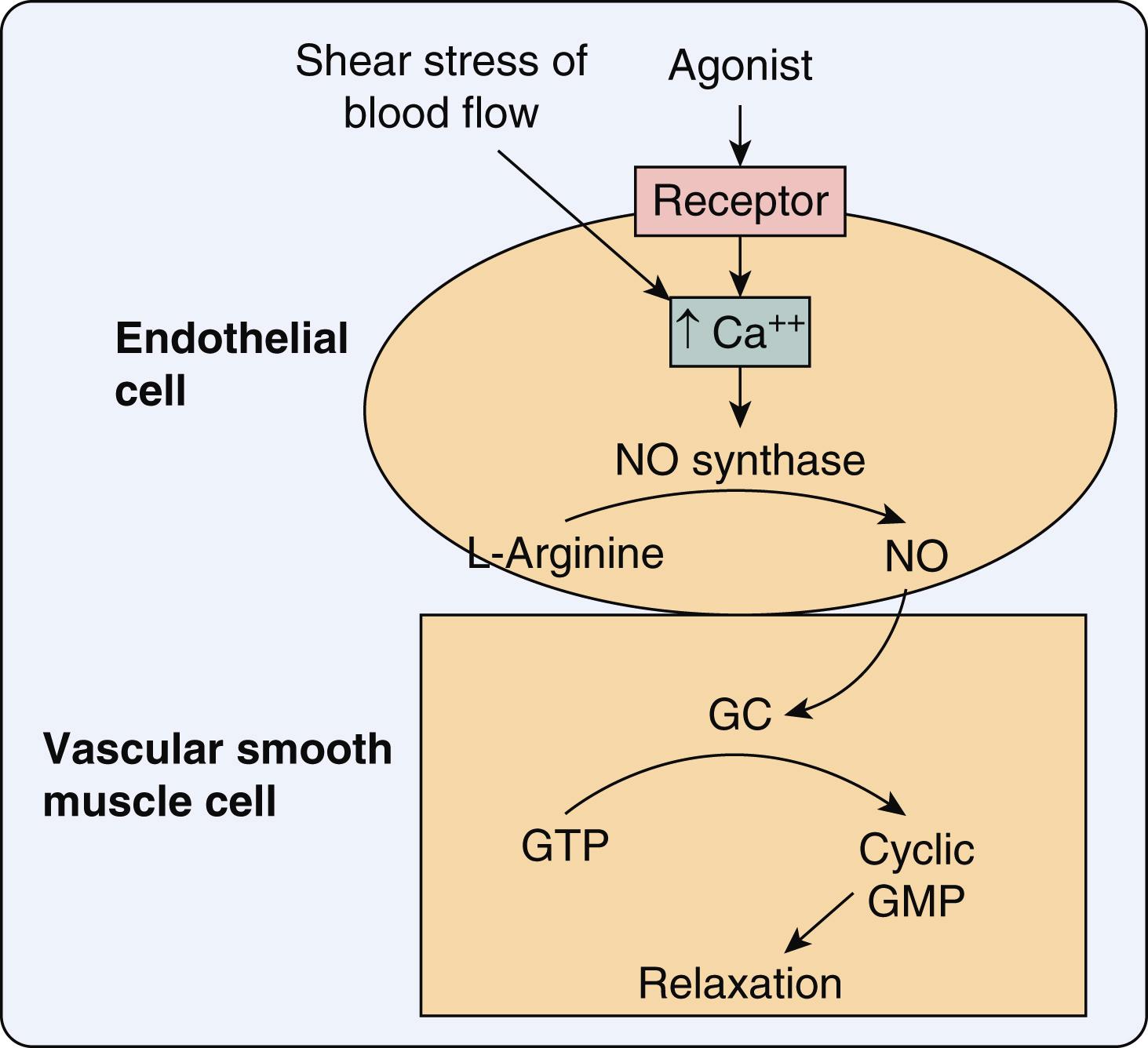
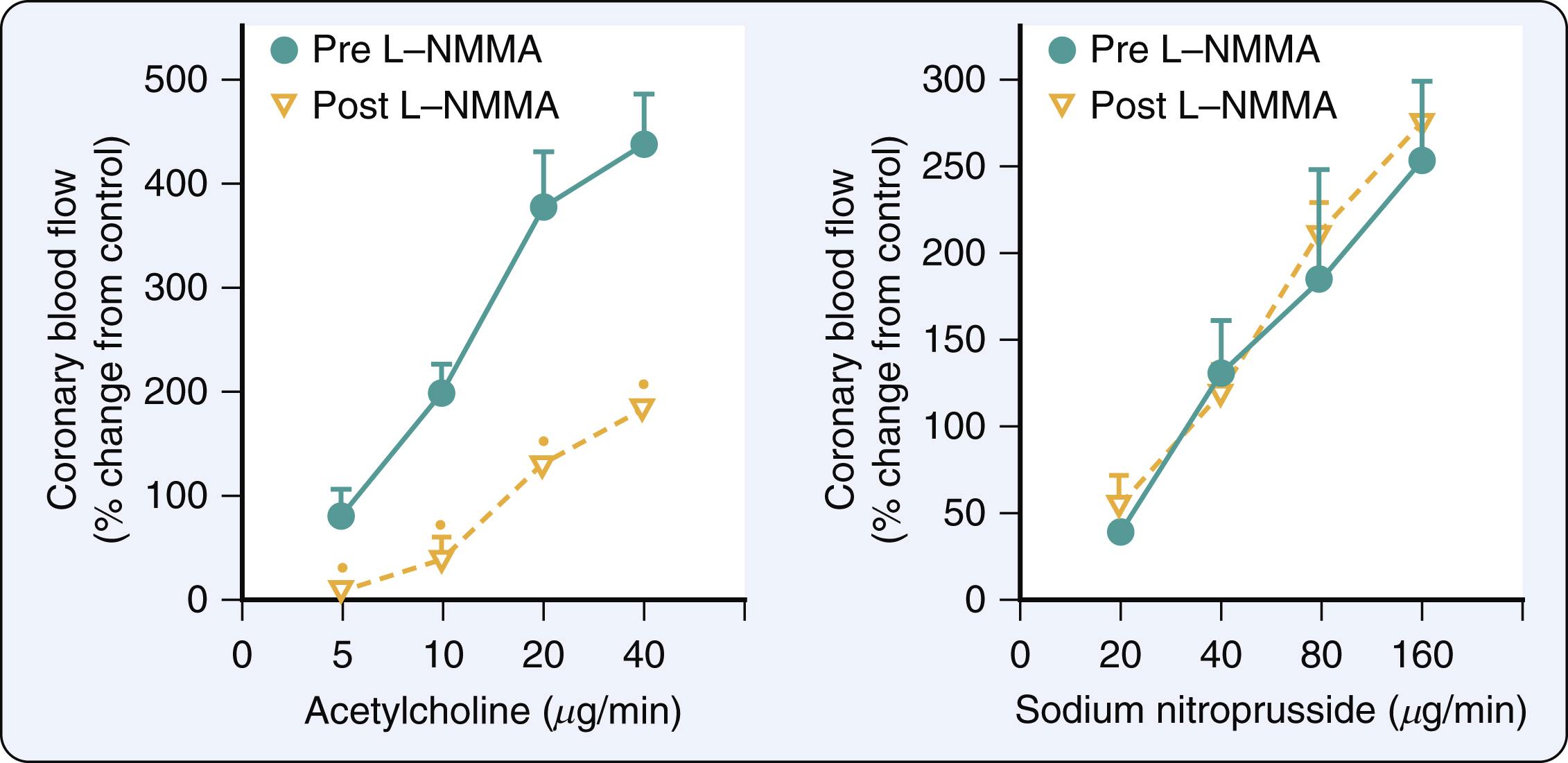
Two additional endothelial-derived vasoactive factors merit discussion: the vasodilator and platelet inhibitor prostaglandin I 2 (prostacyclin) and the vasoconstrictor endothelin-1. Prostacyclin, which was discovered in 1976, is a lipid derivative produced by the action of cyclooxygenase on arachidonic acid, a constituent of the endothelial cell membrane. The mechanism for prostacyclin-induced relaxation of coronary vascular smooth muscle involves receptor-mediated activation of adenylyl cyclase leading to increased intracellular levels of cyclic adenosine monophosphate (cAMP) and an opening of K ATP channels. , Treatment with the cyclooxygenase inhibitor indomethacin did not alter increases in coronary blood flow during treadmill exercise in a canine model, suggesting that prostacyclin does not play an essential role in this local metabolic response.
Endothelin-1, which was discovered in 1987, is an endothelial cell-derived peptide that is the most powerful known endogenous vasoconstrictor. , Endothelin-1 acts by binding to endothelin subtype A and B receptors on the coronary vascular smooth muscle cell. Endothelin-1 release is normally modest and has no important effects in the coronary circulation under baseline conditions. However, excessive production of endothelin-1 may cause coronary vasoconstriction in a variety of pathological conditions such as hyperglycemia, systemic or pulmonary hypertension, heart failure, and during stimulation by angiotensin II, platelet-derived factors, thrombin, cytokines, reactive oxygen species, and local shear forces. NO may serve as an important counter-regulatory mechanism to limit this endothelin-related coronary vasoconstriction.
Potassium channels closed by intracellular ATP were first discovered in cardiac muscle in 1983 and were subsequently identified in vascular smooth muscle 6 years later. The K ATP channel provides a means by which the metabolic status of the cell regulates its level of activity. Opening of K ATP channels causes hyperpolarization of the vascular smooth muscle cells by shifting the membrane potential closer to the K + reversal potential. This hyperpolarization inhibits Ca 2+ entry through voltage-dependent Ca 2+ channels, leading to vasodilation. Studies using glibenclamide (now known as glyburide) to inhibit K ATP channel function have demonstrated involvement of these channels in fundamental processes of coronary vascular control, including maintenance of basal coronary vascular tone. Coronary vasodilation associated with increased myocardial oxygen consumption or reduced perfusion pressure is also mediated by K ATP channels.
Become a Clinical Tree membership for Full access and enjoy Unlimited articles
If you are a member. Log in here